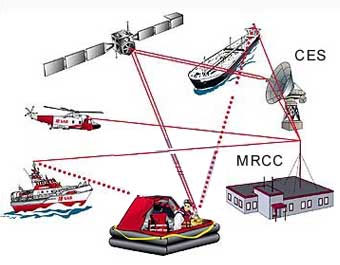PERSPECTIVE ON DVP AND INMARSET HYBRID TERMINALS
 The requirement of providing large asymmetrical Internet connectivity for mobile users especially in the maritime and air travel industry spawned the development of hybrid terminals which provide such connectivity using a mixture of both low cost Inmarsat terminals on the Inmarsat 3 satellites for the uplink and DVB for the high bandwidth downlink.
The requirement of providing large asymmetrical Internet connectivity for mobile users especially in the maritime and air travel industry spawned the development of hybrid terminals which provide such connectivity using a mixture of both low cost Inmarsat terminals on the Inmarsat 3 satellites for the uplink and DVB for the high bandwidth downlink.
The basic idea grew around using the existing Inmarsat terminals like Swift, Fleet and Aero services which were already installed on ships, boats or aircraft for their communications to their controlling offices. These were providing low bandwidth connectivity which was sufficient for their data requirements. The need for Internet services to passengers or users required a modification for providing a high bandwidth downlink for both Internet or TV transmission. This could easily be done using DVB-S standard which provided a means for cheap single way broadband connectivity. Coupling the uplinks using the Inmarsat with the DVB-S downlink provided a relatively cheap solution for asymmetrical connectivity compared to a traditional VSAT solution for the same connectivity.
The provision of this connectivity at the central hub station required an Inmarsat Earth station for receiving the uplink data and a DVB uplink hub where both TV broadcasts and downlink Internet data could be combined on a high bandwidth downlink to service the mobile users on maritime or air traffic. The use of Ku Band for the downlink route to the mobile users provided an easy solution with the large availability of Ku band satellite capacity with regional spot beams.
The development of DVB-S2 provided a greater area of increasing the available downlink capacity for modern Internet users for the downlink. DVB-S2 provides greater data throughput with the same bandwidth as compared to DVB-S and has additional features like Adaptive Code Modulation (ACM) which provides greater assurance for connectivity with lesser bandwidth in case of reduction in signal strength which is a greater advantage in the case of mobile users travelling over long distances using flights which pass through different regions in shorter timeframes. Thus the adoption of DVB-S2 by this method was faster to provide better services.
The presence of BGAN terminals launched by Inmarsat which was more focused towards individual users requiring high bandwidth connectivity rather than user groups did not affect this mode of service very much. But the market dynamics may change with the launch of Inmarsat 5 satellites which would provide Ka band satellite connectivity with higher throughputs at the hand of users. They may provide an alternative for a pure Inmarsat solution with greater bandwidth for users on a global scale ideal for air travelers who constitute an important segment for any Internet service providers on a global scale. Ka Band with smaller
DVB Transmission is also slated to go the Ka Band with greater number of satellites with Ka band capabilities being planned in the future. Thus there will also be an opportunity for the hybrid technology promoters like Nera to look at this option also for extending the present configuration with greater number of satellites to have Ka Band transponders in future. Thus the future of satellite based mobile Internet services is a really exciting space for technology, customers and service providers.
All the information and product details shared here are for the end usage of the Government and Defence Forces

